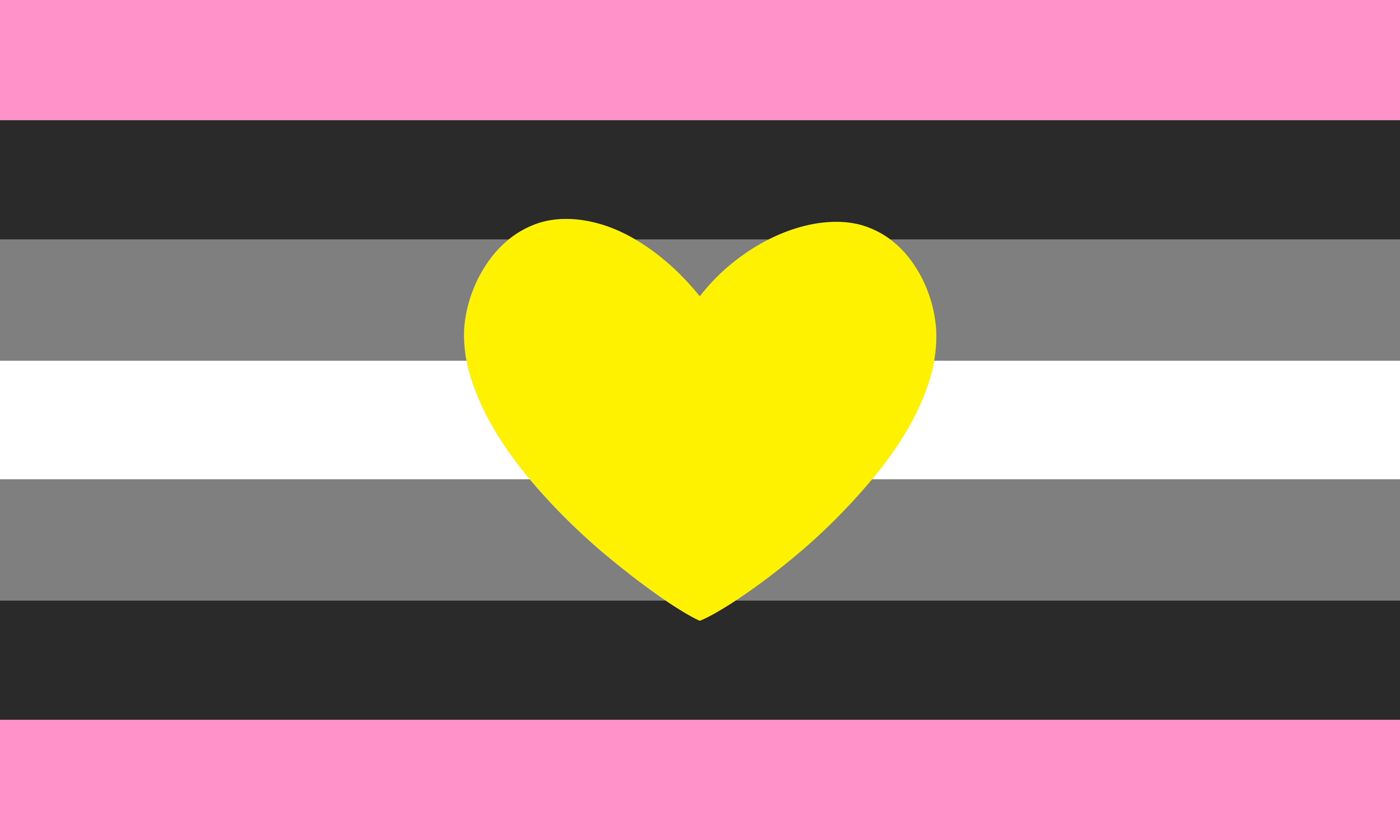|

HOME |
ABOUT | INDEX |
NEWS |
FACEBOOK |
CONTACT
ROMANTIC ORIENTATION
Affectional
Attraction | Emotional Attraction
Romantic
Orientation Defined
Romantic orientation, also called affectional
orientation, indicates the sex or gender with which a
person is most likely to have a romantic relationship or
fall in love. It is used both alternatively and
side-by-side with the term sexual orientation, and is
based on the perspective that sexual attraction is but a
single component of a larger dynamic. For asexual
people, romantic orientation is often considered a more
useful measure of attraction than sexual orientation.
Romantic
attraction is the emotional response that most people often
feel that results in a desire for a romantic
relationship with the person that the attraction is felt
towards. Many asexual people experience romantic
attraction even though they do not feel sexual
attraction.
So, an "aromantic"
or "aro" person is someone who experiences little or no romantic
attraction to others. Where romantic people have an
emotional need to be with another person in a romantic
relationship, aromantics are often satisfied with
friendships and other non-romantic relationships.



Asexual Relationships & Romance
Shades of Grayro: Romantic Orientations
Love Panky: Different Kinds of Romantic Orientations
Info: Platonic Relationships
Is Asexuality a Disorder?
Video Talk: Aesthetic Attraction
Self Discovery: People Share Their Aromantic Stories
What It Means to Be Aromantic
AVEN: Romantic Orientation
Debunking Asexual and
Aromantic Myths
Video: Different Types of Attraction
Facts You Should Know About Aromantic People
Info: Asexuality
Romantic
Identities
Heteroromantic - Romantic attraction towards persons
of the opposite gender
Homoromantic - Romantic attraction towards persons of
the same gender
Biromantic - Romantic attraction towards persons of
either gender
Panromantic - Romantic attraction towards persons of
any and all genders
Demiromantic - Romantic attraction towards anyone, but only after forming a deep emotional bond with
the person
Lithromantic
- Feels romantic attraction towards someone, but does
not have any desire for those feelings to be
reciprocated
Aromantic
- Lack of romantic attraction towards anyone



Psychology Today: Brief Primer on Asexuality
All Your Questions
Answered: What It's Like to be Asexual
Info: Asexuality
Ace and Aro Icons Who Revolutionized How We See
Asexuality
Video Talk: What Does Aromantic Feel Like?
PBS Interview: Asexuality
What Do Asexuals Fantasize About?
Are Asexuals Part of the LGBTQ Community?
It's Okay to be Asexual
Info: Sexual Identity
What Do Asexuals Want You
to Know?
Reciprosexuality and Reciprioromanticism
Video Talk: Being Asexual and Biromantic
Romantic Terminology
Romantic
Relationship - An intimate relationship is one in which
you can truly be yourself with someone who you respect
and are respected by in return. It is an emotional
connection that can also be physical. It does not have
to be in the context of a sexual
relationship.
Primary Sexual Desire - Desire to engage in sexual
activity for the purposes of personal pleasure whether
physical, emotional, or both.
Secondary Sexual Attraction - Sexual attraction that
develops over time based on a person's relationship and
emotional connection with another person.
Aromantic
- Person who experiences little or no romantic
attraction to others. Where romantic people have an
emotional need to be with another person in a romantic
relationship, aromantics are often satisfied with
friendships and other non-romantic relationships.
Demiromantic - Type of grey-romantic who only
experiences romantic attraction after developing an
emotional connection beforehand. Demiromantics do not
experience primary romantic attraction, but they are
capable of secondary romantic attraction. The sexual
counterpart to demiromantic is demisexual.
Lithromantic - Also known as akoiromantic and apromantic,
refers to a person who feels romantic love but does not
have any desire for those feelings to be reciprocated.
If you are lithromantic, you may or may not be
comfortable with romantic relationships. You may or may
not be comfortable with platonic love. Regardless, this
person does not see the need for love in a relationship.
Aroflux -
Romantic orientation on the aromantic spectrum defined
as someone whose romantic orientation fluctuates, but
always stays on the aromantic spectrum.
Quoiromantic - Romantic orientation on the aromantic
spectrum in which someone is unable to define romantic
attraction so unable to say whether or not you
experience it.
Nebularomantic - Term for being unable to or having a
hard time distinguishing romantic attraction from
platonic attraction. The prefix is from the Latin word
“nebulous” meaning “clouded or unclear”.
Autoromantic - Person who experiences intimacy or
romantic feelings towards oneself.
Aro Q&A: My Experience as an Aromantic
People Who Don't Want to Fall in Love
What is Asexuality?
Video: Ace and Aro People in Relationships
Asexuality, Attraction, and Romantic Orientation
Video Chat: Types of Attraction

Aromantic and
Asexual Slang
Ace -
Someone who identifies on the asexual spectrum
Aro - Someone who identifies on the aromantic spectrum
Aro|Ace - Someone who identifies as both aromantic and
asexual
Ace of Spades - Someone who identifies as an aromantic
asexual
Ace of Hearts - Someone who identifies as a romantic
asexual
Romo - Someone
who identifies as a romantic
No Romo - Someone
who identifies as an aromantic
AVEN: Romantic Orientation
Facts You Should Know About Aromantic People
Asexuality, Attraction, and Romantic Orientation
Video Chat: Types of Attraction
Info:
Platonic Relationships
Ace and Aro Icons Who Revolutionized How We See Asexuality
Facts You Should Know About Aromantic
People
Realizing I'm an Aromantic
Asexual
Self Discovery: People Share Their
Aromantic Stories
Asexual Relationships & Romance
Video: Ace and Aro People in Relationships
What It Means to Be Aromantic
Debunking Asexual and
Aromantic Myths
Video Ramblings: Queer Platonic Relationships
What is Lithromantic?
Info: Asexuality
Shades of Grayro: Romantic Orientations
Video: Different Types of Attraction



Types of Attraction
Romantic
Attraction – Affinity to engage in relational,
interactive, affectional, intimate behavior (flirting,
dating, marriage) with another person.
Sexual Attraction – Affinity (desire, interest) to engage in physical
(carnal) intimate contact or behavior
(kissing, touching, intercourse) with another person.
Sensual Attraction - Desire to interact with others in a
tactile, non-sexual way, such as through hugging or
cuddling.
Emotional/Spiritual Attraction – Affinity to engage in
empathetic (interdependent) intimate behavior (sharing, confiding, trusting,
loving) with another person.
Desire to get to
know someone, often as a result of their personality
instead of their physicality. This type of attraction is
present in most relationships from platonic friendships
to romantic and sexual relationships.
Aesthetic Attraction - When someone appreciates the
appearance or beauty of another persons, disconnected
from sexual or romantic attraction.
Intellectual Attraction - Desire to
engage with another in an intellectual manner, such as
engaging in conversation with them, “picking their
brain,” and it has more to do with what or how a person
thinks instead of the person themselves.




Love Panky: Different Kinds of Romantic Orientations
Video Talk: Aesthetic Attraction
Info: Platonic Relationships
Odyssey: Types of Attraction
Asexual Visibility
and Education Network
Akoiromantic Defined
This is What Sex Feels Like for an Asexual Person
What is Friendship?
Psychology Today: Gay Men and Straight Men as Friends
Kai and Mari: Queerplatonic Relationship
Queer Friendships: Platonic and Romantic
Video Advice: Signs You Have Found Your Soulmate
Ace and Aro Icons Who Revolutionized How We See
Asexuality
Relationships,
Squishes, and Zucchini
Being in a relationship does not necessarily imply that
there is romance. The asexual community (including
aromantics) separates sexual and romantic orientation.
There is such a thing as non-romantic loving
relationships. Most people would agree that family is
kind of non-romantic loving relationship, especially
from the mother to the children, but friendship and
companionship may be more important than romantic
partnership even for some romantic people.
Not only is love not exclusive of romance, but even
infatuation. For the latter, the asexual community
coined the term “squish” to refer to an asexual
aromantic crush. And they recently coined the term
“zucchini” to refer to an aromantic platonic
relationship.



Shades of Grayro: Romantic Orientations
What is Lithromantic?
Video Advice: Signs You Have Found Your Soulmate
Info: Sexual Identity
Love Panky: Different Kinds of Romantic Orientations
Reciprosexuality and Reciprioromanticism
Aromantic Poem
Video Chat: Types of Attraction
Asexual Visibility
and Education Network
This is What Sex Feels Like for an Asexual Person
Queerplatonic
Relationships
A queerplatonic relationship (QPR) is one which is more
intense and intimate than what most people regard as a
friendship, not fitting the traditional romantic couple
model. It is characterized by a strong bond, love, and
emotional commitment, yet is not perceived by those
involved as romantic or more than a friendship. Being a
so-called platonic relationship, it does not comprehend
sexuality/eroticism or exclusivity nor it is this what
the relationship is organized around. It is defined by
the intensity and significance of the emotional
connection.
The people involved do not have to identify as queer. It
is a type of relationship experienced by and available
to anybody regardless of their sexual orientation,
romantic orientation, or monogamy. The people involved
in a queerplatonic relationship may consider themselves
partners, life-partners, a couple, a triad, or any other
term that implies the relationship is meaningful,
committed and intimate. Because queerplatonic
relationships are not based on exclusivity, a
participant of the relationship may have multiple QPPs
and exclusive relationships (romantic or sexual) with a
third party not involved in the QPR.



AVEN: Romantic Orientation
Asexuality, Attraction, and Romantic Orientation
Video Talk: Aromantic Spectrum
Facts You Should Know About Aromantic People
Asexual Relationships & Romance
Realizing I'm an Aromantic
Asexual
Info: Asexuality
Queerplatonic partners (QPs or QPPs) are sometimes
referred to as "zucchini.” This was originally a joke
within the aromantic asexual community, underscoring the
lack of words in mainstream relationship discourse to
signify meaningful relationships that do not follow the
standard and expected sexual/romantic norms, and
frustration with the erasure of other kinds of intimacy,
which were perceived as equally valuable to the
sexual/romantic model.
Due to the controversy surrounding the reclamation of
"queer", an alternative to queerplatonic is "quasiplatonic"
or "quirkyplatonic".
In some situations the people involved can show physical
affection such as cheek kisses, pecks on the lips,
holding hands, sitting on each other's lap, seeing each
other naked, cuddling and literally sleeping together.
To QPPs, these activities are not necessarily romantic
nor sexual/erotic.
AVEN: Romantic Orientation
Akoiromantic Defined
Facts You Should Know About Aromantic People
People Who Don't Want to Fall in Love
Info: Platonic Relationships
Video Talk: Being Asexual and Biromantic
Asexuality, Attraction, and Romantic Orientation
Realizing I'm an Aromantic
Asexual
Facts You Should Know About Aromantic People
Odyssey: Types of Attraction
Self Discovery: People Share Their Aromantic Stories
Video Ramblings: Being Queer Platonic
Asexual Relationships & Romance
Info: Asexuality
Alternate Celebrations
Palentine's Day...
Galentine's Day...
Malentine's Day...
Valentine's Day, observed
annually on February 14, has a
long-honored tradition of
affirming and celebrating
romantic love. One of the most
popular holidays on our
calendar, it gives couples, both
straight and queer, the
opportunity to express their
love, affection, and devotion to
each other. Whether you are in a
committed opposite-sex
relationship or same-sex
relationship, Valentine's Day is
the day for you and your partner
to commemorate your monogamous
devotion and loyalty to each
other.
There are those who are not in a
traditional romantic
relationship, but, instead enjoy
being single and value the
non-romantic love and platonic
relationships they have with
their friends. These
connections, while not romantic
or sexual, are none the less
deep and meaningful. For those
enjoying these kinds of loving
relationships, there are
alternatives to Valentine's Day
. . .


Palentine's Day is a day
to celebrate platonic love and
friendship. It is celebrated on
February 13. It honors aromantic
and asexual relationships and
gives friends the opportunity to
celebrate their important
relationship with each other.
Galentine's Day is a day
to celebrate female friendships
and platonic love. It is
celebrated on February 13.
Activities are often all-female,
but can include friends of any
gender. The day is a reminder
for women to support and uplift
each other.
Malentine's Day is a day
to celebrate male friendships
and platonic love. It is
celebrated on February 12. It is
a day for men to meet up and
celebrate their amazing
friendship, but can include
friends of any gender. It is a
the male equivalent of
Galentine’s Day.
Additionally,
Aromantic
Spectrum Awareness Week,
which is observed on the first
full week after February 14,
seeks to commorate and validate
persons in this category.
Relationships|Couples
Marriage Equality
Dating
and Courtship
Aromantic Orientation
Platonic
Relationships

Friendships:
Platonic, Familial, Cordial
Outside of
sexual relationships, friendships are very important.
Depending on the friend, the physical connection would
often play a role as well. From hand holding to
cuddling, in many ways these queer friendships fulfill a
need for physical touch. Beyond dating, friendships and
a variety of platonic relationships often provide a
meaningful source of deep love and happiness.
Many straight women often have close relationships with
other women. But, the component of queer identity makes
a big difference here. The undercurrent of attraction
and the possibility of relationships makes connections
between queer women more nuanced at times. Sometimes
these undefined relationships can be maddening and lead
to jealousy or frustration. Questions like, “What are
we?” and, “What does this mean?” can be nagging. But, on the
other hand, these relationships can also take pressure
off and allow for intimacy in open-ended, freeing ways.



Asexuality, Attraction, and Romantic Orientation
Asexual Relationships & Romance
Debunking Asexual and
Aromantic Myths
Love Panky: Different Kinds of Romantic Orientations
Video Ramblings: Being Queer Platonic
Kai and Mari: Queerplatonic Relationship
Types of Female Friendships
Video Talk: Can Queer and Straight People Be Friends?
Jen and Judy: Someone to Stay
Asexual Visibility
and Education Network
Huffpost: Things Real
Friends Do
Video Advice: Signs You Have Found Your Soulmate
Info: Platonic Relationships
Akoiromantic Defined
Video Chat: Types of Attraction
Realizing
I'm an Aromantic Asexual
BFF Test: Antoni Porowski and Jonathan Van Ness
In general, we live in a culture that values the
romantic/sexual relationship above all others. This is
easy to see. Most popular songs and movies center the
romantic relationship as the most important one in a
person’s life. The monogamous romantic bond is shown as
a shining example of connection and what we all should
strive for in life. All other relationships, be they
platonic, familial, or something more nebulous, are made
to seem secondary to traditional romance. A heterosexual
pairing is held up as the golden ideal, but these same
ideas about pairing off and romance superseding all else
can sometimes translate to the queer community, too.
So, how do we label these close friendships? In an
article, writer Maria Popova addresses romance and
friendship and the history of the ‘neverland between the
two and the inevitable discombobulation of our neatly
organized relationship structures that happens when
romantic love and friendship converge”. Relationships
are never as simple or cut and dried as a definition.
These convergences can cause confusion but also lead to
joy and beauty.



The term "queerplatonic"
is useful here. This phrase was coined by asexual and
aromantic people, and it’s often used in the asexual and
aromantic communities. It’s defined by AVEN as, “a
relationship that is not romantic but involves a close
emotional connection (platonic) beyond what most people
consider friendship. The commitment level in a
queerplatonic relationship is often considered to be
similar to that of a romantic relationship.” This
definition can help us gain insight into ourselves and
our relationships, and allow people to broaden their
perceptions of relationships and love.
Understanding the importance of these types of
relationships can help us realize something about
friendship. Friendships of all kinds (platonic,
romantic, sexual and otherwise) can be life-saving, even
when their parameters aren’t so clear-cut. We can learn
to embrace the ambiguity and enjoy the queer friendships
that provide us with a constant source of intimacy in
our lives.
[Source: Amanda Steele, Tempest, July 2018]
This is What Sex Feels Like for an Asexual Person
Video: Ace and Aro People in Relationships
BFF Test: Antoni Porowski and Jonathan Van Ness
What is Lithromantic?
Self Discovery: People Share Their Aromantic Stories
Info: Platonic Relationships
Video: When You and Your BFF are Practically Married
Psychology Today: Gay Men and Straight Men as Friends
Jen and Judy: What is a Soulmate?
Aro Q&A: My Experience as an Aromantic
Queer Friendships: Platonic and Romantic
What is Friendship?

What is Platonic
Love?
Love is
multi-faceted and comes in many forms: parental, filial,
romantic, platonic. But what do we mean when we say
“platonic friends” or talk about “platonic love”? What
does a modern, healthy platonic relationship look like,
and how do we keep it that way?
Platonic love takes its name from famous Classical Greek
philosopher, Plato (428–347 BCE). Initially, Plato’s
dialogue was directed toward same-sex relationships,
sexual, and otherwise, but by the Renaissance, platonic
love had come to encompass the non-sexual, heterosexual
relationships we know today. Originally, Platonic love
was love that was not vulgar, meaning it wasn’t centered
on lust or fulfilling carnal needs. Instead, it was a
love that inspired nobler pursuits, and brought one
closer to the divine. It brought about the best in both
people.



Shades of Grayro: Romantic Orientations
Video: Ace and Aro People in Relationships
Love Panky: Different Kinds of Romantic Orientations
Asexual Visibility
and Education Network
Info: Sexual Identity
Video Talk: Being Asexual and Biromantic
This is What Sex Feels Like for an Asexual Person
Debunking Asexual and
Aromantic Myths
Clearly,
today this is no longer completely the case. In our
secular world, a platonic relationship has basically
become code for “we’re just friends” (minus the
benefits). In many cases, that person can end up being
someone you’d go to the moon and back for, but just have
no romantic interest in, or attraction to, in a sexual
way.
However, modern notions of platonic companionship are
not completely devoid of its original meaning. Just like
the original idea, platonic love, like romantic love,
can be deep and intense, and form some of life’s best,
and longest friendships.
And like its ancient origins, the expectation of a
platonic relationship today is relatively the same: that
you would treat that person the way you treat a close
friend of the same sex. It is a space where jealousy
doesn’t rear its ugly head, and hidden agendas and
unrequited love are left at the door. It is rooted in
genuine honesty, and the ability to be yourself around
that person without fear of censure, or abandonment.



Characteristics Of Platonic Love
A simple way to sum it up would be: be a good friend,
period. However, this isn’t the answer people are
looking for. Especially at a time when relationships,
and power structures, are changing and are in dire need
of boundaries. The following characteristics of platonic
love will help you recognize it, manage your
expectations of it, and keep that relationship happy,
and healthy, and thriving for years to come.
Unfiltered Honesty
There is little need for deceit in a purely platonic
relationship. Unlike in a romantic relationship, there
is no fear that the person will leave you because they
were never with you in the first place.
You aren’t an item, so the stakes aren’t as high. There
isn’t the same caution, or need to check in with the
other person emotionally. You can have a fight, not
speak for a month, then patch things up, and things will
pretty much go back to normal.
Platonic love doesn’t have to spare anyone’s feelings.
There is no need to maintain a facade. In some sense,
this brutal honesty is great. In fact, it is often a
relief. You can get insights and perspectives you
wouldn’t be able to get from your romantic partner.
Psychology Today: Gay Men and Straight Men as Friends
Queer Friendships: Platonic and Romantic
Realizing I'm an Aromantic
Asexual
Video Chat: Types of Attraction
Info: Platonic Relationships
We're Not Gay: We're Besties
Advantages of Being Just Good Friends
Jen and Judy: What is a Soulmate?
Asexuality, Attraction, and Romantic Orientation
Types of Female Friendships
Video: When You and Your BFF are Practically Married



You can
ask the unaskable questions, and not have to worry too
much about the status of your relationship. You can talk
openly about your dating troubles, and share your
personal gaffes without worrying about how it makes you
look. Platonic love can tell it like it is, and can take
the lumps a romantic relationship cannot because it’s
not as complicated when you’re not busy trying to keep
up appearances and impress someone.
You aren’t putting them first, in the way you would if
you were romantically involved. This doesn’t mean that
you don’t consider other people’s feelings outside of
your own or your romantic partner’s, but there is a
different level of consideration we go to when we have a
romantic end game in mind.
A romantic relationship is less like a rock, and more
like a flower. It has to be carefully cultivated, and
taken care of. It is fragile and liable (like a flower)
to die without the proper attention. This is especially
true once the first flush of love has faded, the
butterflies are gone, and you’ve settled into a
comfortable pattern together. This is when the real work
begins. Platonic love is much less delicate and can
weather these ups and downs.



Psychology Today: Gay Men and Straight Men as Friends
Queer Friendships: Platonic and Romantic
Advantages of Being Just Good Friends
What is Friendship?
Video Advice: Signs You Have Found Your Soulmate
What Is a Platonic Relationship
Types of Female Friendships
Video Talk: Can Queer and Straight People Be Friends?
Jen and Judy: Someone to Stay
Asexuality, Attraction, and Romantic Orientation
Video: When You and Your BFF are Practically Married
Lex and Jonathan: Best Friends' Journey in Queerness
Lonely Dudes: Men Are Having a Friendship Crisis
Respecting Boundaries
While purely platonic relationships may have a no-holds
barred aspect to them (because we don’t hold our friends
to the same standards as we do our lovers), this doesn’t
mean that there are no boundaries. Platonic
relationships require (especially in the beginning)
strong boundaries. These are not normally discussed or
negotiated the way steps are in romantic relationships,
but they hover in the background nonetheless. As time
passes, you will know how far you can push those
boundaries, and when you have to pull back.
For example, when you travel together – do you share a
room? If you do, will that change if one or both of you
gets involved with someone romantically? Platonic love
requires a lot of trust. This is especially true when
you (or your platonic bestie) are in a romantic
relationship.
You have to take care to build trust to ensure that your
partners understand the nature of your relationship, and
that it doesn’t pose any potential threats. If your
significant other has a platonic BFF, how would that
play out for you? What would be considered OK? What
wouldn’t? Ask yourself these questions, and listen to
those feelings. Your gut is often the best indicator of
what constitutes crossing the line, and what is
acceptable.


Huffpost: Things Real
Friends Do
Lonely Dudes: Men Are Having a Friendship Crisis
Asexual Relationships and Romance
Lex and Jonathan: Best Friends' Journey in Queerness
Jen and Judy: Someone to Stay
What Is a Platonic Relationship
Video Ramblings: Being Queer Platonic
What It Means to Be Aromantic
What is Friendship?
Video Advice: Signs You Have Found Your Soulmate
No
Expectations
Although friendship is a give and take partnership, when
it comes to platonic love, you have to be careful not to
expect or demand more of that person than you would of a
regular friendship. Part of what differentiates platonic
from romantic love is expectation. We expect a lot from
our romantic partners because with every person you
date, you’re potentially interviewing them for the role
of life partner, or spouse. If someone wants to spend
their life with you, they need to be of the highest
caliber, and up to scratch.
We are less forgiving of mistakes in romantic
relationships, and in a sense, that’s a good thing; we
need to be picky when it comes to investing that kind of
time in a lifelong companion. Platonic love doesn’t get
held to the same high standard. You’re not sharing a
home, children, pets, bank accounts. You’re close,
(and potentially) lifelong friends.
You get to go home at the end of the night and not worry
about what that person is doing, who they’re with,
whether they paid the electric bill, ate the dinner you
left in the fridge, or hung the laundry to dry. You may
worry about them if they’ve been going through a
difficult time, as naturally good friends do, but you’re
not as invested in their day-to-day meanderings and
external relationships. They simply don’t come first.
If you start to notice that they are coming first, or
that you’re often disappointed by their behavior because
they aren’t living up to your expectations, you may need
to step back and ask yourself: are romantic feelings
creeping in? Are boundaries being crossed? Why am I
demanding this from this person? You may be expecting
too much.


It’s
Not Complicated
Platonic love will always be a part of the human
condition – we award different values to every person we
meet, and we love each one in a unique way. Recognizing
and respecting those differences will bring us closer to
Plato’s initial ideal of platonic love – one that raises
us up and anchors us throughout life.
While love might be fraught with complexities, two-way
platonic affection is the one place where you can
definitively say: it’s not complicated. Platonic
relationships provide an important piece to how we love,
and are loved, through life. They can provide
fulfilling, lifelong friendships, offer us refreshing
perspectives, and a much needed outlet to let off steam,
and let it all hang out.
These are the people who love us minus the baggage, the
“rock” friends who inspire the best in us, and tell us
what we need to hear when we’ve gone astray. Keep your
relationship honest, respect each other’s boundaries,
and let go of expectations. Remembering these key things
will go a long way to a healthy, and happy relationship.
[Source: Sandra Alvarez, Conscious Rethink, May 2019]
Asexual Relationships and Romance
Huffpost: Things Real
Friends Do
Jen and Judy: Someone to Stay
Debunking Asexual and
Aromantic Myths
What It Means to Be Aromantic
We're Not Gay: We're Besties
Lex and Jonathan: Best Friends' Journey in Queerness
Video Talk: Aesthetic Attraction
Reciprosexuality and Reciprioromanticism
Jen and Judy: What is a Soulmate?
Video: Different Types of Attraction
BFF Test: Antoni Porowski and Jonathan Van Ness
Advantages of Being Just Good Friends
Video Talk: Being Asexual and Biromantic
Kai and Mari: Queerplatonic Relationship
Video: Ace and Aro People in Relationships
Aromantic Poem

Friendship
Defined
"I'll be
there for you, When the rain starts to pour,
I'll be there for you, Like I've been there before,
I'll be there for you, 'Cause you're there for me too."
-Rembrandts, Friends Theme
Words
connected with friends or friendship include...
relationship, friendly relationship, close relationship,
attachment, mutual attachment, alliance, association,
close association, bond, tie, link, union, amity,
camaraderie, friendliness, comradeship, companionship,
fellowship, fellow feeling, closeness, affinity,
rapport, understanding, harmony, unity, cordial
relations.
BFF is a term you often hear people use to describe a
"best friend forever."
Friendships are based on mutual liking and respect. It
is state of mutual trust and support between two or more
people.
Platonic describes a relationship that is purely
spiritual and not physical. If a guy and a girl hang out
all the time but aren't boyfriend and girlfriend, they'd
describe their friendship as platonic. Platonic love and
platonic friendships are marked by the absence of
physical or sexual desire.
True friendship is when someone knows you better than
yourself and takes a position in your best interests in
a crisis. Friendship goes beyond just sharing time
together, and it is long lasting. Friendship can mean
different things to different people.



Friendship
means lending your shoulder for someone to cry on.
Friendship means being comfortable around each other in
silence. Friendship means being able to tell each other
anything and understanding without questions. Friendship
means being honest with each other no matter what the
cost.
A true friend has your back. Someone who is a true
friend stands up for you. When others try to hurt you
emotionally or physically, they do everything they can
to make sure you stay safe. They don't care who is
trying to harm you. They will defend you anytime,
anywhere
The true meaning of friendship is when you consider the
other person's well-being to be as valuable as your own.
If you feel this way about a person, you are truly their
friend. If you consider that another person's good is as
important as your own, you will treat them the way
friends are supposed to treat each other.


Types of Friendships
Friendship of Utility - Relationship between you and
someone who is useful to you in some way
Friendship of Pleasure - Relationship between you and
someone whose company you enjoy
Friendship of Interest - Relationship between you and
someone who shares similar interests
Friendship of Respect - Relationship based on
mutual respect and admiration
Types of Friends
Soul Mate
Loyal Best Friend
Fearless
Adventurer
Brutally Honest Confidant
Wise Mentor/Counselor
Zen
Friend/Calming Presence
Care
Giver/Protector
Cheerleader/Supporter
Dependent/Clingy Friend
Polar
Opposite
Friendly Neighbor
Work Pal/Colleague
Friend
With Benefits
Asexual Relationships and Romance
Info: Platonic Relationships
What It Means to Be Aromantic
We're Not Gay: We're Besties
Lex and Jonathan: Best Friends' Journey in Queerness
Video Talk: Aesthetic Attraction
Reciprosexuality and Reciprioromanticism
Jen and Judy: What is a Soulmate?
Video: Different Types of Attraction
BFF Test: Antoni Porowski and Jonathan Van Ness
Advantages of Being Just Good Friends
Video Talk: Being Asexual and Biromantic
Kai and Mari: Queerplatonic Relationship
Video: Ace and Aro People in Relationships
Huffpost: Things Real
Friends Do
Aromantic Poem

Friends With
Benefits
What is
the definition of a Friends With Benefits (FWB)
relationship? Used
as a euphemism, it is a friend with whom one has sex
without a romantic relationship or commitment.
In practice, people involved in a friends with
benefits relationship clearly enjoy spending time
together and hooking up, but their relationship isn't
romantic and has no strings attached.
Two
popular films in 2011 featured this kind of casual
relationship: Friends With Benefits (Starring
Mila Kunis and Justin Timberlake) and No Strings
Attached (Starring Natalie Portman and Ashton
Kutcher).
According to Wikipedia, Friends with benefits
refers to otherwise platonic friends who engage in a
casual sexual relationship.
The Urban Dictionary describes it this way: Two friends
who trust each other enough to engage in sexual activity
without fear of hurting the other's feelings. It is the
ideal scenario for folk who are not interested in a
serious relationship, or who do not have time for one.
Not a boyfriend or girlfriend. Neither party has to
refrain from dating other people. It is a smart
alternative to random hook-ups.
Example: John and I are friends with benefits. We just
hang out, and have sex. It's easy, now that we've
established the ground rules. If we stopped having sex,
we'd still be friends.
Related terms for Friends With Benefits (FWB) include
Fuck Buddies (FB), Friend Sex, Casual Sex, Bud Sex, and No
Strings Attached (NSA). Generally FWB behavior is
differentiated from One Night Stands, Hooking Up, and
Booty Calls.



Healthy
FWB Relationship
The sexual
part of a new connection can be easy to fall into, of
course. But what about the "friends" element? A friend
is typically someone you trust and who trusts you—a
relationship that develops through shared history,
experiences, situations, circumstances, compatibility,
or mutual interests. When you're looking for an FWB
arrangement with someone from the start, you're forcing
a new potential relationship into a box that may not
fit, with a label that may misrepresent it. Since it
takes time to cultivate a friendship, it logically
follows that it should require time and dedication to
find out if one can or should cultivate a friendship
with benefits with someone.
Why? Because the benefit is sex, and any time sex is
involved, it complicates matters, even when both people
try to maintain communication and mutual respect. For an
FWB arrangement to work, you have to know each other.
You have to have a sense of who both of you are with and
to each other. And you have to understand what feelings
the emotional and sexual dynamic evokes in you.
Maintaining an FWB in a healthy way means communicating
about what each person expects and where each is as the
relationship evolves. Whether it feels comfortable and
safe, or problems arise, if there is room to work
through challenges to maintain the friendship, even at
the expense of the benefits, then you are in a
successful connection. There is a mutual investment in
each other's well-being, because you're friends first.
But regardless of how the relationship is labeled, when
you’re sexually involved with someone you already care
deeply for, emotions build, as does trust, intimacy,
connection, and familiarity. And, no matter what one
calls the arrangement, it can still get tricky. Check in
to make sure that your friend is still your friend and
that it's not getting more challenging to maintain your
status, or is in any way becoming off-putting for you or
for them.
[Source:
Dr. Suzanne Lachmann, Psychology Today, Feb 2015]
Friends With Benefits: What Does It Really Mean?
Rules of Being Friends With Benefits
Maintaining an FWB Relationship
Video Explanation: Friends With Benefits
Dating Advice: Truth About Friends With Benefits
Guide to Being Friends With Benefits
FWB: How Can You Tell If It's Not Working?



Rules of
Being Friends With Benefits
When you are involved in an FWB relationship, laying
some ground rules can save you a lot of drama. Kicking
off a friends-with-benefits relationship can be a lot of
liberating fun. After all, it's a hookup with no strings
attached between two people who genuinely like and trust
each other. But, of course, that doesn't necessarily
mean it's uncomplicated.
It's hard to prescribe a clear-cut set of rules for
being friends with benefits. Every situation is
different. But there is one thing these relationships
all have in common: a need for some good old-fashioned
communication. It should be an honest transaction
between friends. It’s always a good idea to talk about
what the expectations are, preferably in advance.
There's a lot of frank talk before the fun stuff, but
things can get a little knotty if both parties aren’t on
the same page.
Be clear about what you’re looking for. Whenever you’re
deciding the rules in a FWB relationship, it’s best to
be as transparent as possible, open to compromises, and
never be judgmental or make the conversation one-sided.
Always come from a place of honesty and care. Trying to
keep things casual doesn’t mean that you have to be cool
and just go along with what your partner wants. Speak up
for yourself and advocate for what you want too.



Don’t expect it to turn into a romantic relationship. Be
sure you’re okay with this being exactly what it is and
nothing more. It is important to be aware of one’s own
true intentions and feelings when entering into an
arrangement like this.
Check in intermittently with how you’re feeling. Let
your friend with benefits know that you want to make
sure you both are on the same page. It's an important
step in making sure you're not hurting each other's
feelings down the line. If at some point you’re enjoying
yourself too much and want to spend more time with your
FWB, then it may be time to reevaluate the situation. If
you’re getting too attached, then it’s time to have a
discussion
And try to get a read on your partner's feelings too. "Hey, just
want to check in with you about how things are going
between us."
These types of conversations can really help prevent
future meltdowns and will also strengthen the
friendship, the trust, and the vulnerability with each
other. Plus, it’ll keep one person from reading into the
relationship more than the other. If emotions evolve for
one or both of you, have the conversation again and
reevaluate your FWB relationship. Since a FWB
relationship can change quickly, you want to make sure
you check in with each other as often as needed to avoid
misunderstandings.
Talk about how you’re going to talk about it. Be sure to
lay out your PR strategy, especially if you’re part of
the same group of friends. Are you keeping it under
wraps? Are you going to be open about it the next time
you’re all out at the bar and the two of you duck off
into the night together? This is not the thing to be
caught off guard about.
Lay down some ground rules. Will either of you be
sleeping over? Are booty calls allowed? Other partners?
These things cross different boundaries for different
FWB situations, so figure it out ahead of time, or don’t
be afraid to gently nip it in the bud early on.
Know where to draw the line. Even if these are the best
orgasms you’ve ever had, this isn’t the same as having a
romantic partner. Communication is about the wheres and
whens of hooking up. You are not building an intimate
relationship, but rather just having fun and enjoying
one another physically.
Acknowledge your own comfort zone. Just because you’re
keeping it casual doesn’t mean you have to be complacent
when it comes to red lines and consent. Know your
limits. The more up front you are about them, the
better. But don’t hesitate to speak up at any point.



Be sure you’re using protection. Depending on the
expectations you’ve set, either of you might be hooking
up with multiple people. And that’s great! Just be sure
you’re being safe. If it’s a heterosexual relationship,
it’s probably good to let your partner know what kind of
birth control you’re using. For any type of ongoing
nonexclusive hookup, make sure you discuss how often you
each plan to get tested for STDs and STIs. So if you’re
in more than one casual relationship, you definitely
need to let your new FWB know, and, of course, use
condoms every single time.
Talk about how it’s going to end. Assuming you’re not
sexing off into the sunset together, it’s way better to
talk about the end before it happens. What if they meet
someone they want to be exclusive with? What if you do?
And what happens if someone decides they’re just not
into it anymore? It might be hard to visualize the end
of something, but it'll potentially save a lot of
heartache to acknowledge that it might not last forever
early on. Let them know you plan to talk about it if you
meet someone else, and that they should feel free to do
the same. That way, you run less of a risk of losing the
friendship when you stop having sex.
And, of course, make sure it's fun. For all the horrors
of the current sociopolitical situation, one blessing is
that we can have sex with whomever we want, whenever we
want, should the circumstances permit, and that doesn’t
have to be someone we’re in a long-term, committed
relationship with. Sex can be a great way to de-stress,
has more than a few amazing health and beauty benefits,
and is a hell of a lot of fun. And the minute your
friends-with-benefit situation stops being fun? Call it
off. That, after all, is the true beauty of the casual
arrangement.
[Source: By Krystin Arneson, Glamour Magazine, March
2019]
Friends With Benefits: What Does It Really Mean?
Rules of Being Friends With Benefits
Maintaining an FWB Relationship
Video Explanation: Friends With Benefits
Dating Advice: Truth About Friends With Benefits
Guide to Being Friends With Benefits
FWB: How Can You Tell If It's Not Working?
HOME
QUEER CAFE
│ LGBTQ Information Network │ Established 2017 |